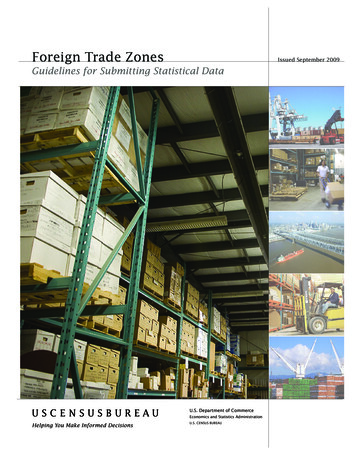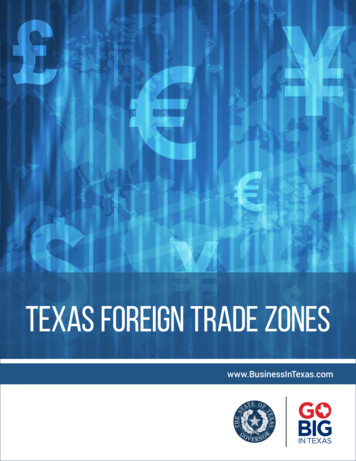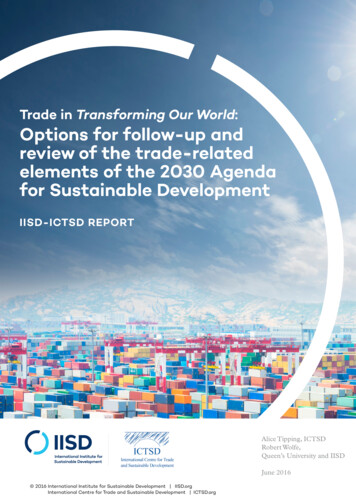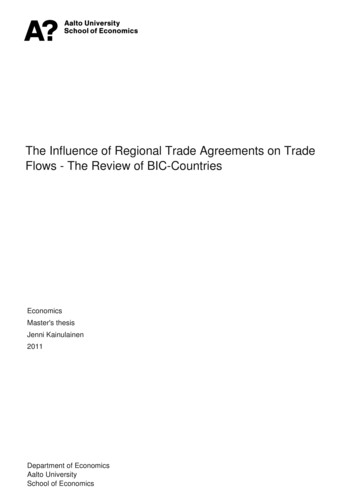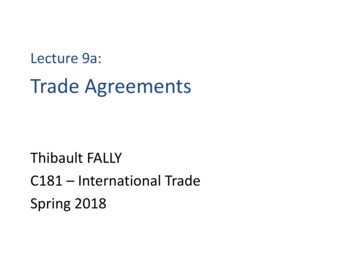
Transcription
The U.S.Foreign-Trade ZonesProgramInformation for CBP
WHAT IS A FOREIGN-TRADE ZONE? Foreign-Trade Zones (FTZs) are locations in U.S. designated by the FTZBoard where merchandise can be imported prior to formal entry and dutypayment Zone activity cannot occur until a site is designated by the FTZ Board andthen “activated” by CBP Zone activity remains under the direct supervision of CBP FTZs encourage U.S. activity and jobs – in competition with foreignalternatives – by allowing delayed or reduced duty payments on foreignmerchandise, as well as other savings
WHAT ACTIVITY IS PERMITTED IN FTZs? In an FTZ, merchandise may be assembled, exhibited, cleaned,manipulated, manufactured, mixed, processed, relabeled, repackaged,repaired, salvaged, sampled, stored, tested, displayed, & destroyed “Production” (manufacturing/processing) activity needs specific advanceapproval by FTZ Board Retail trade is prohibited. No one can reside in an active FTZ. All other federal, state, and local laws apply– FDA, TTB, and EPA all have regulations that apply to FTZs
FTZ vs BONDED WAREHOUSE Both are designated areas that provide duty benefits under CBP supervision However, in FTZs:– No time limit on goods– Domestic and foreign goods can comingle– Wide range of production activity may be authorized
WHO’S WHO IN FTZs FTZ Board Commerce (chair) and Treasury departments. FTZ Staff located at Commerce Makes decisions on requests for FTZ sites and activity Customs and Border Protection (CBP) Advises the FTZ Board on applications Oversees FTZ activity (incl. making decisions on requests to activate)
WHO’S WHO IN FTZs - GranteeFTZBoardGrantee – Has received agrant of authority from theFTZ Board to sponsor one ormore FTZ sites in its region.Usually a public entity (city,county, port authority or/User
WHO’S WHO IN FTZs - OperatorOperator - A corporation,partnership, or person thatoperates a zone or subzoneunder agreement with thegrantee, with the concurrenceof the Port Director of CBP.The operator has the bondwith CBP.FTZBoardGranteeOperatorIn some zones, the granteemay also be the operator.UserUserGranteeOperatorUserOperator/User
WHO’S WHO IN FTZs - UserFTZBoardUser - A party usinga zone underagreement with thezone grantee oroperator. Usersoften own themerchandisehandled byoperators.A user may also bean operator (i.e.,handling its atorUserOperator/User
POSSIBLE FTZ SAVINGS TO COMPANIES Duty Exemption. No duties on or quota charges on re-exports becausethe merchandise is never entered for consumption. Duty Deferral. Payment of duties and federal excise tax deferred onimports until entry is made. Inverted Tariff. Where FTZ production (manufacturing/processing) resultsin a finished product with a lower duty rate than the rate on the foreigncomponent(s), the finished product may be entered at the duty rate thatapplies to its condition as it leaves the zone. (Reminder: Any suchproduction activity requires advance approval by the FTZ Board.)
POSSIBLE FTZ SAVINGS TO COMPANIES Logistical Benefits. Companies using FTZ procedures may have access tostreamlined customs procedures (e.g., "weekly entry" or "direct delivery"). Scrap/Waste. Duty may be reduced on foreign articles that becomescrap/waste through FTZ activity. Other Benefits. Foreign goods and domestic goods held for export areexempt from state/local inventory taxes. FTZ status may also make a siteeligible for other state/local benefits.
TWO “FRAMEWORKS” FOR GRANTEES’MANAGEMENT OF THEIR ZONE SITES Traditional Site Framework: Default approach that hasexisted – with evolutions in FTZ Board practice – sincebeginning of FTZ program in 1934. Alternative Site Framework: Option that grantee can requestfor shift (“reorganization”) in management of existing zone orestablishment of new zone. Adopted as part of FTZ Boardpractice in 2008, incorporated into the Board’s regulations in2012.
TRADITIONAL SITE FRAMEWORK (TSF) Expansions/reorganizations must be approved by the FTZBoard (lengthy process) Minor boundary modifications (MBMs) – to meet certain timesensitive needs – involve swapping acreage from an existingsite to create a new one Problems: Inflexible for companies. Many situations will not qualify for MBM Can encourage grantees to establish sites speculatively that maynever get used (but that CBP has agreed to oversee) Recordkeeping difficult due to swapping of acreage
ALTERNATIVE SITE FRAMEWORK (ASF) Developed to address problems with TSF Grantee gets FTZ Board approval to reframe zone to serve broader“service area” Simplified MBMs can then be used – with CBP concurrence followedby approval of FTZ Board staff – to designate sites for individualcompanies’ needs within the approved service area Essentially all sites get “sunset” limits that remove designation ifunused in 3 to 5 years No swapping needed for minor boundary modifications Zone will be subject to 2,000-acre activation limit
ALTERNATIVE SITE FRAMEWORK – KEY TERMS Service Area – is the geographic area where grantee wants to beable to propose usage-driven sites/subzones– Most commonly will be specific counties– The entire Service Area must meet the FTZ “adjacency”requirement – that is, be within 60 miles/90 minutes’ drivingtime of CBP port of entry limits– In a few parts of the country, closely clustered CBP Ports ofEntry may lead to grantees proposing partially overlappingService Areas. CBP would need to consider whether theoverlap would cause problems for CBP’s oversight of thezones.
ALTERNATIVE SITE FRAMEWORK – KEY TERMS Magnet Site – selected by grantee based on ability to attractmultiple potential FTZ operators/users.– Designated only via action by full FTZ Board after lengthyprocess (incl. public comment period)– Akin to traditional FTZ site (industrial park, port facility, etc.)designated in advance – essentially speculatively – to attemptto draw FTZ operators/users– Generally subject to a five-year sunset provision
ALTERNATIVE SITE FRAMEWORK – KEY TERMS Usage-Driven Site/Subzone – designated for a company ready topursue conducting FTZ activity– Can be designated by FTZ Board staff via quick, simple MBMprocess (with no swapping of acreage required)– Designation tied to the specific company and limited to thespace needed by the company– If company vacates its designated Usage-Driven/Subzone site,the FTZ designation terminates– Subject to a three-year sunset provision
WHERE CAN ZONES BE LOCATED TSF and ASF sites (incl. Magnet and Usage-Driven/Subzoneunder ASF) Must be located either within or “adjacent” to CBP port –meaning within 60 statute miles or 90 minutes’ driving time fromthe outer limits of a port of entry (15 CFR 400.11(b)(2)) Other Subzones May be located beyond 60 miles/90 minutes driving time if CBPcan adequately oversee the activity (including throughelectronic supervision)
FINDING ZONE SITE INFORMATION To confirm that a zone site exists and can be activated, use FTZBoard’s online tool – Online FTZ Information System (OFIS)On the FTZ staff’s main page - www.trade.gov/ftz - click on the OFISlink under the FTZ Board sealFrom the menu on the left select “Zone and Site Information”Choose the zone, and click “open”At the bottom of the screen will be a list of sites, you can click “open”next to any of the sites for additional information and a map of that site
ZONE SITE INFORMATION As of fall 2015, the zone structure in ACE is not yet complete Until the system is complete, the FTZ staff can only add site informationinto ACE if the site is part of a subzone Once complete, the FTZ staff will add zone site information to ACE Currently: to activate an operator within a magnet or usage-driven site,CBP must enter zone site information as well as operator information
INFORMATION AVAILABLE IN ACE General zone info (approval date, grantee information)FTZ Board decisions and Federal Register notices since 1980Any restrictions or manufacturing approvals for each zone will be listedin the “Remarks” fieldRecent application records also include a copy of the application andexaminer’s reportSubzone Information:– FTZ Board decisions and Federal Register notices since 1980(including applications and examiner’s reports for recent actions)– Restrictions will be listed in the “Remarks” field– Site Information
APPLICATION TYPES Minor Boundary Modifications (for action by FTZ Board staff) Applicable to TSF or ASF. Under the ASF, this includesusage-driven sites and subzones within the approved servicearea Time frame for FTZ Board staff review -- 30 days Company or grantee will request comments from CBP toinclude as part of the application CBP comments should indicate whether the port will be able toadequately oversee the proposal and if there are any otherconcerns
APPLICATION TYPES Zone Expansions or Reorganizations (TSF or ASF) Time frame for FTZ Board review – 7.5 - 10 months FTZ Board staff will send a letter to CBP requesting commentsafter the application has been formally docketed CBP comments should indicate whether any proposed sitesand the entirety of any proposed service area meet theadjacency requirement and if there are any otherissues/concerns
APPLICATION TYPES Subzone Applications (non-ASF) Time frame for FTZ Board review – 3 or 5 months FTZ Board staff will send a letter to CBP requesting commentsafter the application has been formally docketed CBP comments should indicate whether the proposed subzonesite(s) meet the adjacency requirement and if there are anyother issues/concerns
APPLICATION TYPES New Zone Applications (new grantees) Applicant can choose either TSF or ASF Time frame for FTZ Board review –10 months FTZ Board staff will send a letter to CBP requesting commentsafter the application has been formally docketed CBP comments should indicate whether any proposed sitesand the entirety of any proposed service area meet theadjacency requirement and if there are any otherissues/concerns
APPLICATION TYPES Production Notifications 120-day FTZ Board process FTZ staff will send a letter to CBP requesting comments after theapplication has been formally docketed CBP comments should address whether the port has any issues orconcerns with the proposed activity
APPLICATION TYPES Interim Production Authority (while applicant awaits FTZ Board decisionon Production Notification at end of standard 120-day process) Can be approved by FTZ Board’s Executive Secretary to coverperiod until FTZ Board action on production notification To seek interim authority, company must be in a position to usethe authority (incl. activate site(s)) before the end of the standard120-day decision process for notifications. Company wouldrequest comments from CBP. Such comments should cover: Is the company already activated or on track to activatesooner than the 120-day notification period? Does CBP have any concerns regarding the activity?
APPLICATION TYPES Production Applications 12 month FTZ Board process A company may submit a production application if FTZ Boarddid not approve all of company’s requested productionauthority through the notification process FTZ Board staff will send a letter to CBP requesting commentsafter the application has been formally docketed CBP comments should address whether the port has anyissues or concerns with the proposed activity
WHERE TO FIND APPLICATION DOCUMENTS To find a copy of the application and (where applicable) FederalRegister notice:– Log in to ACE– Click on “Accounts”, then choose “FTZ Operator” and click “GO”then click “Records” and select the zone number at the bottom ofthe screen.– Click on the “Documents” tab to find the docket information
CBP INPUT (COMMENTS) ON APPLICATIONS Reflecting the time-sensitive nature of MBMs and requests for interimproduction authority (while FTZ Board conducts 120-day process tomake decision on production notification), the grantee or operator willcontact the CBP port directly to request comments/concurrence forMBMs and interim production requests. For all other application types – incl. non-ASF subzones, expansions,reorganizations and production notifications – after the FTZ Board hasstarted processing the application, the Board staff will contact the CBPport to request comments/concurrence.
DURING AND AFTER APPLICATION PROCESS Company’s pre-activation process with CBP can run concurrent withthe FTZ Board/staff reviewing the company’s application for FTZ site(s)and/or production authority. Once the FTZ Board has made a decision on an application, the CBPPort that submitted comments will be notified.
COMMON RESTRICTIONS ON FTZ APPROVALS Approval of an application may be subject to restrictions Common restrictions include: 2,000-acre activation limit Expiration dates or sunset limits on sites For production activity, approval for export only or requirement thatcertain merchandise be placed in Privileged Foreign (PF) status Note: All merchandise subject to AD/CVD orders must be admitted inPF status (15 CFR 400.14(e)(2))
COMMON RESTRICTIONS ON FTZ APPROVALS TSF - Sites may be subject to sunset limits that are dependent onactivation/use of the site within a certain time frame– In some cases, sites may have expiration dates - absolute timelimits regardless of zone activityASF - Sunset Limits are dependent on activation/use of the site within acertain time frame– Each site (with possible exception of 1 magnet site) approvedunder ASF usually has a 3 or 5 year sunset limit– ASF magnet sites will maintain FTZ designation if activated withinthe sunset period– ASF usage-driven sites/subzones must not only be activated butalso receive foreign-status merchandise during the sunset period
FTZ PRODUCTION ACTIVITY Prior approval by the FTZ Board needed for any activity that changesthe 6-digit HTSUS classification or changes the eligibility of an articlefor entry into the U.S.– Includes kitting (examples: imported glassware and a bottle ofliquor placed in a box and entered as a gift set ; an imported batterycombined with a cell phone into a retail package) Approval is limited to the specific foreign-status components andfinished products approved by the FTZ Board Use of new imported components or production of new finishedproducts would require additional approval from the FTZ Board
REFERENCE FTZ Act of 1934 -- 19 USC 81a-81u FTZ Board’s Regs 15 CFR 400– Revised in 2012– Include criteria for establishing FTZ authority CBP FTZ Regs 19 CFR 146– Describe CBP day to day oversight FTZ Manual for CBP– Includes information, procedures and processes related to FTZ activity
ACE AND ACTIVATIONS Tips:– Zone Site # Assigned by FTZ Board (check with FTZ staffor website to confirm)– Site # alphanumeric code (A1, B1, Z6 ) CBP chooses todistinguish between operators within a zone site
FTZ Board Staff Contacts by RegionRegionStatesStaff ContactNorthernConnecticut, Illinois, Indiana, Iowa,Kentucky, Maine, Massachusetts, Michigan,Minnesota, New Hampshire, New York,Ohio, Pennsylvania, Rhode Island,Vermont, WisconsinLiz Whiteman(202) , Delaware, Florida, Georgia,Maryland, New Jersey, North Carolina,South Carolina, Tennessee, Virginia, WestVirginiaChris Kemp(202) 482-0862Christopher.Kemp@trade.govCentralArkansas, Kansas, Louisiana, Mississippi,Missouri, Nebraska, North Dakota,Oklahoma, Puerto Rico, South Dakota,TexasCamille Evans(202) 482-2350Camille.Evans@trade.govWesternAlaska, Arizona, California, Colorado,Hawaii, Idaho, Montana, Nevada, NewMexico, Oregon, Utah, Washington,WyomingQahira El-Amin(202) 482-5928Qahira.El-Amin@trade.gov
WHAT IS A FOREIGN-TRADE ZONE? Foreign-Trade Zones (FTZs) are locations in U.S. designated by the FTZ Board where merchandise can be imported prior to formal entry and duty payment Zone activity cannot occur until a site is designated by the FTZ Board and then “activated” by CBP Zone activity remains under the direct supervision .File Size: 1MBPage Count: 43


